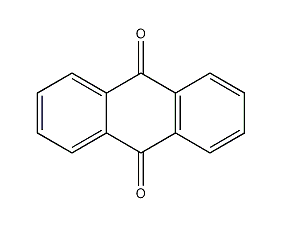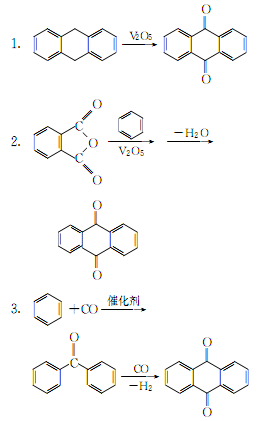
Structural formula
| Business number | 01UX |
|---|---|
| Molecular formula | C14H8O2 |
| Molecular weight | 208.21 |
| label |
9,10-anthraquinone, smoke stone, smoky quartz, 9,10-Anthraquinone, paper chemicals, Aromatic aldehydes, ketones and their derivatives |
Numbering system
CAS number:84-65-1
MDL number:MFCD00001188
EINECS number:201-549-0
RTECS number:CB4725000
BRN number:390030
PubChem number:24899312
Physical property data
1. Properties: light yellow needle-shaped crystals, easy to sublimate.
2. Relative density (25℃, 4℃): 1.0667292.7
3. Relative density (20℃, 4℃): 1.438 p>
4. Melting point (ºC): 286
5. Boiling point (ºC, normal pressure): (ºC, 1.33kpa) 397-381℃
6. Boiling point (ºC, 5.2kPa): 377
7. Refractive index: Undetermined
8. Flash point (ºC): 185
9. Specific rotation (º): Undetermined
10. Autoignition point or ignition temperature (ºC): Undetermined
11. Vapor pressure (kPa, 25ºC): Undetermined
12. Saturated vapor pressure (kPa, 60ºC): Undetermined
13. Heat of combustion (KJ/mol): Undetermined
14. Critical temperature (ºC): Undetermined
15. Critical pressure (KPa): Undetermined
16. Log value of oil-water (octanol/water) partition coefficient: Undetermined
17. Explosion upper limit (%, V/V): Undetermined
18. Explosion lower limit (%, V/V): Undetermined
19. Solubility: Easily soluble in Hot benzene and hot toluene are insoluble in cold benzene. Slightly soluble in water, ethanol, ether, acetone, chloroform and other organic solvents, soluble in concentrated sulfuric acid.
Toxicological data
1. Acute toxicity:
Rat caliber LD50: 15mg/kg; rat inhalation LC50: >1300mg/m3/4H;
Rat skin LD50: >1mg /kg; mouse abdominal cavity LC50: 3500mg/kg;
Mouse skin LC50: >5mg/kg
Bird LD50: >2mg/kg
2 , Other multiple dose toxicity:
Rat caliber TDL0: 10500 mg/kg/7D-I;
3. Teratogenicity
Salmonella: 2 ug /plate; Salmonella: 333 ug/plate;
Mouse: 250mg/kg;
Hamster embryo: 100 ug/L
Ecological data
None yet
Molecular structure data
1. Molar refractive index: 58.66
2. Molar body. Because the process is simple and the raw materials are cheap, it has attracted people’s attention.
5.Carboxy synthesis method Add a measured amount of benzene to the reaction kettle, pass CO at 4.88MPa, reverse 4H at 200°C, and pass until CO The pressure no longer drops and the reaction ends. processed products. The reaction formulas of each method are as follows:

6. Tobacco: OR, 41.
Purpose
Most of anthraquinones are used in dyes, but the amount used as a steaming aid for paper pulp has increased rapidly.
(1) Used in the production of dyes, anthraquinone is used as raw material. After sulfonation, chlorination, nitration, etc., a wide range of dye intermediates can be obtained, which can be used to produce anthraquinone-based disperse dyes, acid dyes, and reduction dyes. Dyes, reactive dyes, etc. form a dye category with full chromatography and good performance. According to statistics, there are more than 400 varieties of anthraquinone dyes, which occupy a very important position in the field of synthetic dyes.
(2) When used as cooking agent for papermaking and pulping, only a small amount of anthraquinone is added to the alkaline cooking liquid to speed up delignification, shorten cooking time, increase pulp yield, and reduce waste. fluid load. Currently, more and more paper mills are using anthraquinone additives. The consumption of anthraquinones as cooking additives is growing rapidly. Anthraquinones have other applications. Anthraquinone compounds can be used to produce high-concentration hydrogen peroxide; in the fertilizer industry, they are used to manufacture the desulfurizing agent anthraquinone disulfonate sodium. Used as dye discharge auxiliary in printing and dyeing industry.
(3)Used as a cooking auxiliary for papermaking and pulping, it can reduce the amount of alkali used and shorten the cooking time.

 微信扫一扫打赏
微信扫一扫打赏

